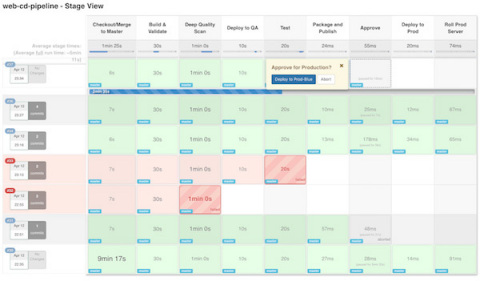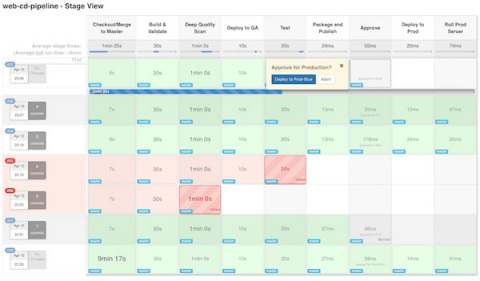SAN JOSE, Calif.--(BUSINESS WIRE)--The Jenkins project, comprised of the community of practitioners using open source Jenkins, today announced the availability of Jenkins 2.0. The first major release after 10 years and 655 weekly releases, Jenkins 2.0 addresses the demands of teams challenged with matching the pace of continuous software delivery while ensuring quality and providing visibility across the full software delivery process. Updates to core Jenkins capabilities include first-class support for continuous delivery (CD) pipelines, clear visibility of delivery stages and enhancements to help users get started more quickly.
“As Jenkins user adoption continues to grow into millions of users, the community has responded with core updates to assure continued, long term success,” said Kohsuke Kawaguchi, creator of Jenkins and CloudBees CTO. “The Jenkins 2.0 release helps new and existing users implement continuous delivery with the most flexible way to model, orchestrate and visualize the entire delivery pipeline.”
Jenkins 2.0 Updates
Continuous Delivery Pipeline Support:
The Pipeline plugins
provide orchestration of all stages of the software delivery process,
with enhanced visibility and feedback. Jenkins 2.0 has several updates
to support continuous delivery pipelines.
- Pipeline-as-Code enables teams to quickly create and collaborate on simple to advanced CD pipelines using code.
- Stage View enables teams to visualize, collaborate and act on the application delivery value stream in real time (see Figure 1, above).
- Pipeline Durability ensures that long-running pipelines withstand outages by resuming at the point of interruption, significantly improving productivity.
- Multibranch provides automatic, zero-configuration of CD pipelines for new branches and pull-requests.
Usability Enhancements:
Jenkins 2.0 includes several
enhancements that make it easier to use, and enable users to quickly be
more effective.
- Get started more quickly with community-recommended plugins: A new quick start UI provides solution-oriented plugin bundles. These are the most commonly-used plugins, selected from the more than 1,000 available plugins, to enable a fast start for new installations (see Figure 2, above).
- Better user experience: Jenkins 2.0 includes enhanced configuration pages and other UI updates to make configuring and using Jenkins more efficient.
- Upgrade confidently: Today millions of users depend on Jenkins, making backwards compatibility a primary concern. Jenkins 2.0 is designed as a drop-in replacement for Jenkins 1.x.
- New community website: In response to the rapidly growing Jenkins community, the new Jenkins website makes it easier for new users to get started with Jenkins, encourages user contribution and increases visibility into Jenkins events.
"By providing pipeline-as-code capabilities and visualization of software pipeline status within Jenkins, Jenkins 2.0 allows me to define both simple and complex pipelines," said Shashikant Jagtap, DevOps and automation engineer, Jenkins user and lead for the London-based Jenkins Area Meetup. "These new features will ultimately enable us to implement robust continuous delivery process automation and deliver higher quality software faster than before."
Additional Resources:
-
Attend the TweetChat about Jenkins 2.0 today – April 26, 1pm EDT:
Log on to Twitter and search for #jenkins2 -
Learn more about Jenkins 2.0:
https://jenkins.io/2.0/ -
Download Jenkins 2.0:
https://jenkins.io -
Attend the virtual Jenkins Area Meetup on May 4, 2016 to learn more
about Jenkins 2.0:
http://www.meetup.com/Jenkins-online-meetup/events/230154841/ -
Register for Jenkins World 2016, the Jenkins community user
conference:
http://www.jenkinsworld.com
About Jenkins and the Jenkins Community
Jenkins is the
leading open source automation server supported by a large and growing
community of developers, testers, designers and other people interested
in continuous integration, continuous delivery and other modern software
delivery practices. Built on the Java Virtual Machine (JVM), it provides
more than 1,000 plugins that extend Jenkins to automate with practically
any technology software delivery teams use.
The Jenkins community advocates the use of Jenkins to the global development community, serving as a central source for tutorials, forums and other helpful resources for Jenkins users of all experience-levels. By recognizing the numerous contributors to the Jenkins project, the Jenkins project creates and fosters a community-powered infrastructure for maintaining and further developing Jenkins. You can follow the Jenkins community on Twitter (@JenkinsCI).



